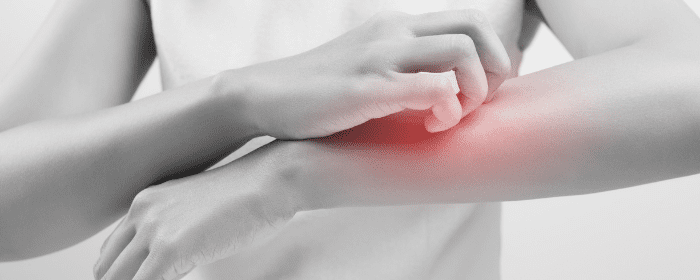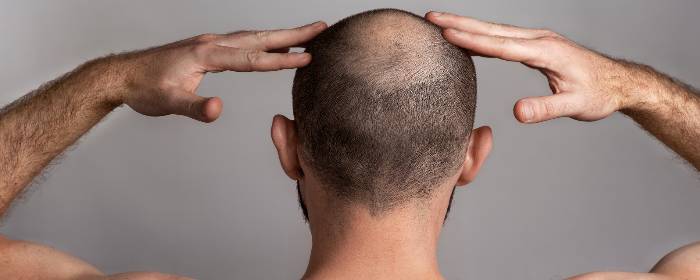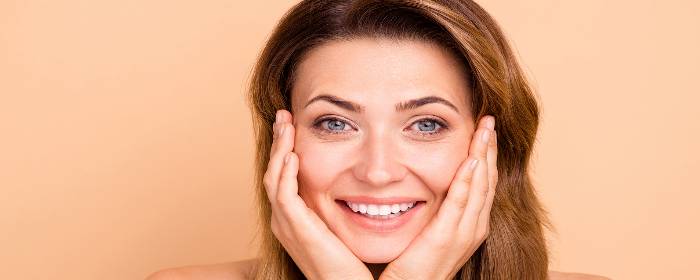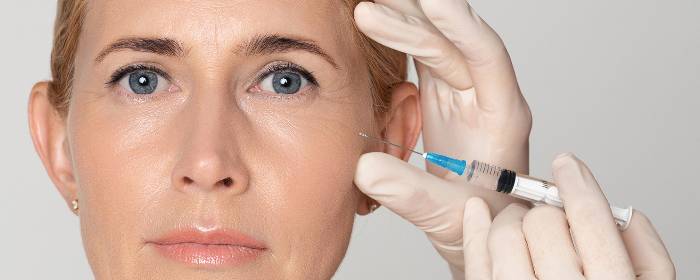
by admin | Feb 24, 2020 | Aesthetics, Exosomes
Atopic dermatitis, better known as eczema, is a chronic, itchy skin disease. People with eczema have chronically dry skin, often in patches, that can be intensely itchy. The patches of atopic dermatitis vary from red bumps (papules or vesicles) when they are inflamed, to dry, scaly, pink areas when they are not inflamed. Patients with eczema itch so frequently that the skin in the lesion can thicken and harden, a process called lichenification. Even patients who manage to clear the lesions usually have a recurrence (i.e. the itchy patches come back).
Patients with eczema can try lotion and moisturizers to
soften the skin and reduce itchiness, but these are only helpful temporality
and only seem to work for people with mild disease. Often, topical
corticosteroids are required. Steroids are applied to areas of atopic
dermatitis to reduce inflammation and itchiness. In severe cases where steroids
are not fully helpful, light therapy (phototherapy) may be needed. Patients may
require more intense therapy for atopic dermatitis such as cyclosporine, methotrexate,
azathioprine, mycophenolate mofetil, or dupilumab. These medications have their
own set of side effects, so they are reserved for people with severe, chronic
eczema. Certainly better, safer treatments for atopic dermatitis are needed.
To this end, researchers conducted the first of its kind study to answer whether exosomes retrieved from mesenchymal stem cells taken from human adipose tissue (i.e. fat tissue) could relieve symptoms of atopic dermatitis in laboratory mice. Mice with experimental atopic dermatitis have similar symptoms to humans with the disease; they have itchy, red lesions that cause the skin to thicken. In the research study, treatment with stem cell-derived exosomes significantly improved the clinical score in these mice. In other words, stem cell exosome treatment reduced redness, swelling, scaling, dryness, and itching. Exosome treatment also reduced objective signs of inflammation including inflammatory cytokines (TNF, IL4, etc.), inflammatory antibodies (IgE), and inflammatory cells (eosinophils).
These results indicate that treatment with stem cell-derived
exosomes substantially reduced symptoms in mice with atopic dermatitis. Of
course, this work needs to be replicated in humans, but this important work
lays the foundation for future clinical trials.
Reference: Cho, BS. et al. (2018). Exosomes derived from
human adipose tissue-derived mesenchymal stem cells alleviate atopic
dermatitis. Stem Cell Research & Therapy. 2018, Jul 11;9(1):187.

by admin | Dec 27, 2019 | Health Awareness, Aesthetics, Age Management, Skin Care
Maintaining healthy, luminous skin isn’t impossible, but it does require some self-care. Fortunately, many of these steps are quick, simple, and can be introduced easily into your daily routine. And, because many of the strategies to boost skin wellness also go hand-in-hand with overall healthy habits, you may even see some other benefits as a result. Here are some of the most powerful ways to improve your skin’s health naturally. Here are 7 beauty tips for naturally vibrant skin.
Always Remove Your Makeup
Your skin needs to breathe while you’re resting, but makeup
can clog your pores and prevent it from getting the air it needs. To keep
imperfections like blackheads and blemishes at bay always remove your makeup
every night before bed – no exception. If you don’t have time to wash your face
entirely, at least use a cotton pad and olive oil to gently remove lingering
cosmetics.
Get Plenty of Wholesome Nutrients
Every system in your body requires proper nutrition to
function its best, and your skin is no different. Foods
rich in healthy fats, including fatty fish, avocadoes, and nuts, are
especially powerful for keeping skin hydrated and supple. Nutrient-rich foods
like vegetables, fruit, and lean protein will also help round out a
skin-healthy diet.
Exercise Regularly
Exercise
increases blood flow, which helps to boost skin health. When you get
active, circulation increases, which carries essential nutrients to the skin.
Plus, increased blood flow also helps to carry away waste such as free
radicals, which could otherwise exacerbate the signs of aging.
Stay Hydrated
Every single cell in your body requires water
– especially your skin cells. Your skin is an organ made up of water, and
without enough hydration, it can begin to look flaky, dull, and aged. Be sure
to get at least glasses a day to keep your skin looking its best.
Sleep Soundly
The signs of a poor night’s sleep are likely to show up on
your skin immediately, in the form of puffy eyes or undereye bags. Yet, a
pattern of bad sleep can also take its toll on your skin. Because cells
regenerate during sleep, getting ample rest is essential to fighting the signs
of aging. Aim for at least eight hours of shut-eye each night to promote a
natural glow.
Keep Your Skin Moisturized
Dry skin loses its elasticity and makes it easier to spot
fine lines and wrinkles. For this reason, you should be applying a gentle
moisturizer every morning and evening. Look for one with natural,
non-irritating ingredients, especially if you have sensitive skin.
Never Skip Sunblock
The final but most important rule for maintaining healthy skin is to apply sunblock each and every day. Even if you’re only outdoors briefly, UV damage can add up, and will eventually lead to wrinkles, sun spots, and other signs of aging. Make sure your moisturizer has an SPF of 30 or higher, and that it can block out both harmful UVA and UVB rays to keep your skin not only safe, but healthy-looking.

by admin | Oct 17, 2019 | Aesthetics, Hair Regrowth, Stem Cell Therapy
Androgenetic alopecia is the medical term for pattern baldness. Pattern baldness can manifest in several ways such as a receding hairline, a bald spot in the crown of the head, and/or generalized thinning hair. Pattern baldness is the most common form of hair loss. Approximately 4 out of 5 men will experience some degree of androgenetic alopecia by the time they reach age 70. Androgenetic alopecia affects a substantial number of women as well. Pattern baldness is not lethal, but it can create substantial amounts of psychological suffering and greatly diminishes the quality of life for both men and women.
The two first-line treatments for androgenetic alopecia in men are finasteride or minoxidil. Finasteride is an oral medication, while minoxidil is topical, i.e. it is placed on this directly on the scalp. These baldness treatments are modestly effective in a certain percentage of men. Patients may also be treated with dutasteride, light therapy, platelet-rich therapy, or surgery. Minoxidil is the main form of treatment for women with androgenetic alopecia. If minoxidil fails to help regrow hair or stop the balding process, women may alternate treatments including spironolactone, finasteride, cyproterone acetate, or flutamide. As with male pattern baldness, female pattern baldness is somewhat resistant to treatment, leaving most women to cover their baldness with wigs or concealers.
One important observation about androgenetic alopecia is that while the number of hair follicle stem cells remains the same in people who are balding, the number of more actively proliferating progenitor cells drops dramatically. In other words, it is theoretically possible to treat androgenetic alopecia with hair follicle stem cells that contain actively proliferating progenitor cells.
Indeed, researchers recently tested this hypothesis in a group of 11 patients with androgenetic alopecia. The researchers collected a bit of tissue from each patient and then purified the sample to collect hair follicle stem cells with actively proliferating progenitor cells. The doctors then injected those stem cells into balding areas on the patients’ scalps. For comparison, some were treated with a placebo injection, i.e. saltwater.
Patients treated with hair follicle stem cells enjoyed a 29% increase in hair density over the treated area. by contrast. Patients treated with placebo had less than a 1% increase in her density over the same time period. The researchers also noticed that they were substantially more stem cells in and around hair follicles in balding areas.
The authors of this research concluded that isolated cells are capable of improving hair density in patients with androgenetic alopecia. While additional, larger studies are needed to confirm these results, the current study provides strong evidence that bald and balding patients may benefit from autologous stem cell treatment.
Reference: Gentile P. et al. (2017). Stem cells from human hair follicles: first mechanical isolation for immediate autologous clinical use in androgenetic alopecia and hair loss. Stem Cell Investigation. 2017 Jun 27;4:58.

by admin | Oct 1, 2019 | Aesthetics, Stem Cell Research, Stem Cell Therapy
You don’t need a microscope to recognize aging skin. Aging skin has fine lines and wrinkles; it sags because it has lost elasticity; it is discolored and blotchy. But if you did look at aging skin under a microscope, you would notice that it lacks collagen, elastin, and many other helpful proteins. There would be many old cells and a few young ones. Indeed, old skin looks different under a microscope than new skin, and it is these differences at the cellular level that causes the aging we see on people’s faces. Stem cell facial therapy may be an option for one seeking to improve or prevent the signs of aging.
Fortunately, these cellular changes may not be a curse. Stem cell therapy may be able to replace the proteins that are lost during aging and replace old cells with newer, healthier cells. In short, stem cell facial therapy may be able to can rejuvenate skin and reverse the signs of aging.
The team of Korean stem cell researchers recently completed a study in which they collected mesenchymal stem cells from various sources and used them to rejuvenate human skin. The researchers collected stem cells from fat tissue (adipose), bone marrow, and umbilical cord samples. Umbilical cord tissue is tissue that is normally discarded after childbirth as medical waste. In the laboratory, the scientists then cleaned and purified each of these types of mesenchymal stem cells.
In laboratory studies, the researchers found that mesenchymal stem cells produced substantial amounts of skin rejuvenating factors including collagen type I, collagen type IV, fibronectin, and elastin. Interestingly, they found that umbilical cord mesenchymal stem cells produced a 100-fold greater amount of GDF-11 than adipose or bone marrow stem cells. This is important because GDF-11 is a cytokine that stimulates the production of collagen and elastin. GDF-11 also attracts human dermal fibroblasts (i.e. healthy skin cells) that then, in turn, produce their own collagen and elastin. These substances make skin healthy, elastic, vibrant, plump, and full.
Given the remarkable amounts of GDF-11 that umbilical cord-derived stem cells produced, the researchers decided to conduct a clinical trial to test the effect of these cells on aging skin. The scientists created a cream that contained the substances produced by the stem cells, including exosomes and beneficial proteins. The women who volunteered for the study applied the cream to their faces once per day. Within 2 to 4 weeks, the women had increased skin density (i.e. thickness/fullness) and substantially reduced wrinkles, especially around the eyes. Moreover, treatment with the stem cell-derived cream did not cause irritation, stinging, or any other adverse reaction.
This clinical study will need to be repeated in larger numbers of volunteers; however, the results are quite remarkable. Researchers were able to collect stem cells from umbilical cord tissue and prepare a cosmetic that reversed some of the signs of facial aging. Conveniently, this treatment did not require injections but could be applied topically. If future research confirms this work, treatment with a cosmetic/cosmeceutical made from umbilical cord stem cells could be a painless way to achieve facial skin rejuvenation.
Reference: Kim, YJ. (2018). Conditioned media from human umbilical cord blood-derived mesenchymal stem cells stimulate rejuvenation function in human skin. Biochemistry and Biophysics Reports. 2018 Oct 25;16:96-102.

by admin | Sep 2, 2019 | Aesthetics, Stem Cell Therapy
No matter how young we may feel, our aging skin often gives our age away. As we age, we lose important proteins in the skin like collagen and elastin. We also lose a thin layer of fat that lies just below the skin. Without this fat and protein, the skin sags and loses its elasticity (“bounce back”) appearing thin and wrinkly.
One of the main skin rejuvenation techniques is to inject fat into aging skin. In its most basic form, a bit of fat is removed from the patient via liposuction and injected into an area of aging skin. These transplanted fat cells give the skin a plumper appearance and seem to turn back the clock on skin aging. However, mature fat cells do not last forever, and many people need to have repeated skin rejuvenation procedures to maintain the effect.
More recently, however, physicians have realized that they achieve better results when they include stem cells in their fat grafts. The mature fat cells provide a beauty benefit immediately, while stem cells help maintain the effect longer. Some physicians have taken the procedure so far as to only inject stem cells and remove mature fat cells completely. While this approach seems reasonable, is unclear whether the stem cell-only approach is actually superior.
While the benefit of fat grafts that include stem cells is widely known, it is unclear how the process works. By understanding the process, researchers hope to learn what provides the strongest antiaging effect. To help them better understand the skin rejuvenation process of fat-derived stem cells, researchers performed liposuction on several patients and then reinjected fat cells and stem cells into areas of aging skin. Three months later, the researchers took samples of the skin to see what effect the combination of fat cells and stem cells had on the skin structure.
While the specific results are quite complex, researchers found that a fat graft that included adipose-derived stem cells improved the elasticity of the skin by creating what is known as an “oxytalan elastic network.” These fibers helped to smooth out the skin and allowed it to retain more moisture than it did before skin rejuvenation treatment.
Perhaps most importantly for patients, the skin rejuvenation procedure left patients with fuller, younger-looking skin.
The researchers concluded that the most beneficial skin rejuvenation approach is to inject a combination of fat cells and stem cells derived from fatty tissue. The benefits were the same as those obtained by injecting stem cells alone. The researchers argue that the combination approach provides a good clinical benefit with the added benefits of being easier to perform, cheaper, and less prone to complications.
Reference: Charles-de-Sá, L. et al. (2015). Antiaging treatment of the facial skin by fat graft and adipose-derived stem cells. Plastic and Reconstructive Surgery. 2015 Apr;135(4):999-1009.

by admin | Aug 21, 2019 | Adipose, Aesthetics, Hair Regrowth
Alopecia, better known as hair loss, is a cosmetic problem. People do not need hair on their scalp to survive. Nonetheless, people with thinning hair or hair loss often endure considerable distress and suffering. Hair loss can cause low self-esteem, symptoms of depression, and a diminished quality of life. So while hair loss may be a simple cosmetic, strictly speaking, many people with alopecia struggle with an ongoing and serious problem.
Unfortunately, there are few effective treatments for hair loss. The two main medical treatments for hair loss are minoxidil and finasteride. Finasteride is generally only useful for male pattern baldness. Both men and women can use minoxidil, but it, too, is only partially effective. Various surgeries can be used to treat hair loss such as hair transplantation, scalp reduction, and scalp expansion, but patient satisfaction rates for these procedures are fairly low.
Stem cells that have been derived from fat tissue (i.e. adipose) secrete a number of beneficial chemicals called cytokines. These cytokines are important for wound healing and new blood vessel growth (i.e. angiogenesis). Cytokines released by adipose-derived stem cells are also able to stimulate hair follicles and induce the growth of hair. Based on these successes in the laboratory, dermatologists in Japan have used the substances secreted by adipose-derived stem cells to help people with hair loss.
Drs. Fukuoka, Narita, and Suga published a report detailing their successes in treating hair loss with proteins extracted from adipose-derived stem cells. A single hair loss treatment involves making a number of very small injections into the scalp. Each patient usually needs 6 to 8 treatment sessions, given once per month.
The doctors have performed this stem cell-based hair loss treatment on more than 1,000 patients and they have not encountered a single allergic reaction or infection. Indeed, no serious complications have occurred in their patients.
Not only is this stem cell-based hair loss treatment safe, but it is also apparently effective, as well. Patients have new growth of thin hair after two or three treatments, but this is minor and can usually only be detected by the doctors. After the fourth or fifth treatment, however, patients often notice new hair growth. By the sixth treatment, most patients can easily see new hair growth.
To confirm the effectiveness of their treatment, the doctors performed a half-side comparison test. In this test, they injected the stem cell-based hair loss treatment on one side of the scalp and injected saline on the other. The side of the scalp that received the stem cell extract had significantly more hair growth than the saline-treated side. This is strong evidence that the treatment is effective.
Reference: Fukuoka H. et al. (2017). Hair Regeneration Therapy: Application of Adipose-Derived Stem Cells. 2017;12(7):531-534.







 St. Petersburg, Florida
St. Petersburg, Florida
